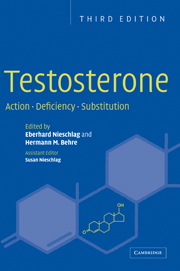Book contents
- Frontmatter
- Contents
- List of contributors
- Preface
- 1 Testosterone: an overview of biosynthesis, transport, metabolism and non-genomic actions
- 2 The androgen receptor: molecular biology
- 3 Androgen receptor: pathophysiology
- 4 Behavioural correlates of testosterone
- 5 The role of testosterone in spermatogenesis
- 6 Androgens and hair: a biological paradox
- 7 Androgens and bone metabolism
- 8 Testosterone effects on the skeletal muscle
- 9 Androgens and erythropoiesis
- 10 Testosterone and cardiovascular diseases
- 11 Testosterone and erection
- 12 Testosterone and the prostate
- 13 Clinical uses of testosterone in hypogonadism and other conditions
- 14 Pharmacology of testosterone preparations
- 15 Androgen therapy in non-gonadal disease
- 16 Androgens in male senescence
- 17 The pathobiology of androgens in women
- 18 Clinical use of 5α-reductase inhibitors
- 19 Dehydroepiandrosterone (DHEA) and androstenedione
- 20 Selective androgen receptor modulators (SARMs)
- 21 Methodology for measuring testosterone, DHT and SHBG in a clinical setting
- 22 Synthesis and pharmacological profiling of new orally active steroidal androgens
- 23 Hormonal male contraception: the essential role of testosterone
- 24 Abuse of androgens and detection of illegal use
- Subject Index
18 - Clinical use of 5α-reductase inhibitors
Published online by Cambridge University Press: 18 January 2010
- Frontmatter
- Contents
- List of contributors
- Preface
- 1 Testosterone: an overview of biosynthesis, transport, metabolism and non-genomic actions
- 2 The androgen receptor: molecular biology
- 3 Androgen receptor: pathophysiology
- 4 Behavioural correlates of testosterone
- 5 The role of testosterone in spermatogenesis
- 6 Androgens and hair: a biological paradox
- 7 Androgens and bone metabolism
- 8 Testosterone effects on the skeletal muscle
- 9 Androgens and erythropoiesis
- 10 Testosterone and cardiovascular diseases
- 11 Testosterone and erection
- 12 Testosterone and the prostate
- 13 Clinical uses of testosterone in hypogonadism and other conditions
- 14 Pharmacology of testosterone preparations
- 15 Androgen therapy in non-gonadal disease
- 16 Androgens in male senescence
- 17 The pathobiology of androgens in women
- 18 Clinical use of 5α-reductase inhibitors
- 19 Dehydroepiandrosterone (DHEA) and androstenedione
- 20 Selective androgen receptor modulators (SARMs)
- 21 Methodology for measuring testosterone, DHT and SHBG in a clinical setting
- 22 Synthesis and pharmacological profiling of new orally active steroidal androgens
- 23 Hormonal male contraception: the essential role of testosterone
- 24 Abuse of androgens and detection of illegal use
- Subject Index
Summary
Role of 5α-reductase in androgen physiology and pathophysiology
Normal androgen metabolism
During the last century, the identification and characterization of the major sex steroids, which include androgens, estrogens, and progestins, helped define their biologic functions. Androgens were demonstrated to be essential for normal male sexual differentiation in utero and for development and maintenance of male secondary sexual characteristics, including terminal body hair growth, muscle mass, sexual behavior and fertility. Androgens are steroid hormones and, as such, produce effects by binding to an intracellular receptor, forming a hormone-receptor complex that interacts with DNA to modulate protein transcription (Mainwaring 1977). Testosterone, the major circulating androgen in adult men, was logically suspected to be the hormone responsible for these effects. Observations in 46XY subjects with inborn androgen insensitivity (syndrome of testicular feminization) confirm that the sexual phenotype in humans is predominantly female in the absence of androgen effects (Morris et al. 1963, see Chapter 3). Specifically, despite normal circulating levels of testosterone, subjects with androgen insensitivity who have impaired responses to androgens secondary to a dysfunctional androgen receptor manifest female external genitalia (with blind vaginal pouch, cryptorchid testes and infertility) and breast development, no terminal sexual body hair growth, and a pre-pubertal pattern of scalp hair growth. Due to the absence of androgen action, no androgen-related disorders typical of aging men, such as disorders of the prostate or male pattern hair loss over the scalp, are observed. The latter finding is consistent with Hamilton's conclusions regarding the androgen dependence of typical male pattern scalp hair loss, based on observations of eunuchs compared to normal subjects (Hamilton 1942; 1951).
- Type
- Chapter
- Information
- TestosteroneAction, Deficiency, Substitution, pp. 571 - 596Publisher: Cambridge University PressPrint publication year: 2004
- 3
- Cited by

